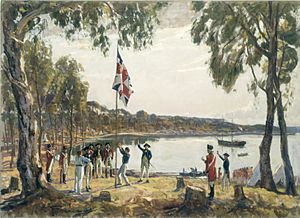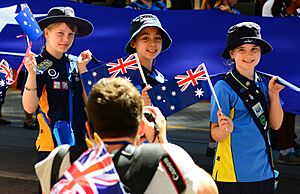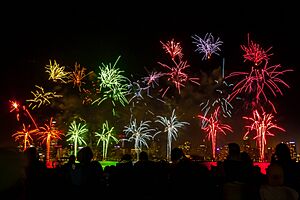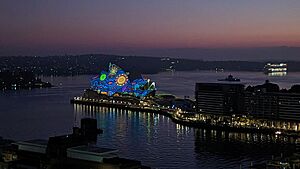Australia Day facts for kids
Quick facts for kids Australia Day |
|
|---|---|
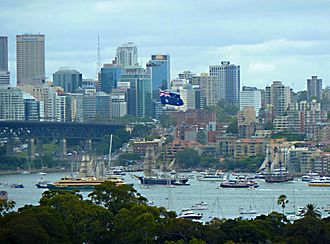
Sydney Harbour on Australia Day, 2014
|
|
| Also called | Anniversary Day, Foundation Day, Survival Day, Invasion Day |
| Observed by | Australian citizens, residents and expatriates |
| Type | National |
| Significance | Date of landing of the First Fleet in Port Jackson in 1788 |
| Observances | Family gatherings, fireworks, picnics and barbecues; parades; citizenship ceremonies; Australia Day honours; Australian of the Year presentation |
| Date | 26 January |
| Frequency | Annual |
Australia Day is the official national day of Australia. It is celebrated every year on 26 January. This date marks the day in 1788 when the First Fleet of British ships arrived at Sydney Cove. On that day, the Union Flag was raised by Arthur Phillip in New South Wales.
Today, Australia Day celebrations show off the country's diverse people and beautiful landscapes. People celebrate with family and community events, picnics, and barbecues. There are also official awards and citizenship ceremonies to welcome new Australians.
Over time, the meaning of Australia Day has changed and been debated. For many years, different states celebrated different dates. It wasn't until 1935 that all Australian states and territories called 26 January "Australia Day." By 1994, it became a public holiday across the whole country on that specific date. Historically, it was also known as Anniversary Day or Foundation Day.
On Australia Day, important awards like the Australian of the Year are given out. The Australia Day Honours list is also announced. The Governor-General and Prime Minister give speeches. It's a public holiday everywhere in Australia. Many communities hold festivals, concerts, and citizenship ceremonies. Australia Day has become the biggest yearly public event in Australia.
However, for some Indigenous Australians, 26 January is a day of sadness. Since 1938, many have seen it as the day the British invaded their land. They protest its celebration as a national holiday. They call it Invasion Day, Survival Day, or Day of Mourning. These groups want the date to be changed or the holiday removed. While most Australians support the current date, some, especially younger people, are open to changing it.
Contents
History of Australia Day
The First Fleet Arrives
On 13 May 1787, a group of 11 ships, called the First Fleet, left England for Australia. Led by Captain Arthur Phillip, their goal was to start a penal colony (a place for prisoners) at Botany Bay in New South Wales. This area had been explored and claimed by Lieutenant James Cook in 1770. The British needed a new place for prisoners after losing their American colonies.
The Fleet arrived at Botany Bay between 18 and 20 January 1788. But it quickly became clear that Botany Bay was not a good spot. So, on 21 January, Phillip and some officers explored Port Jackson, about 12 km north. They found a better place and named it Sydney Cove, after a British official. They also met some local Aboriginal people.
On 25 January, one ship, HMS Supply, made it to Sydney Cove. Captain Phillip and about 40 convicts were on board. Early on 26 January, Phillip and a small group rowed ashore. They officially claimed the land for King George III. The rest of the ships arrived later that day.
The official start of the Colony of New South Wales actually happened on 7 February 1788. That's when the colony was formally announced and Arthur Phillip became governor.
Early Celebrations: 1788 to 1838
Even though 26 January wasn't officially recognized at first, people started celebrating it. By 1808, immigrants, especially former convicts, would gather to celebrate their new home. They would have parties with food and drinks.
In 1818, Governor Lachlan Macquarie held the first official celebration. It was the 30th anniversary of the colony. He made it a holiday for all government workers. He also ordered a 30-gun salute, one for each year the colony had existed. This started a tradition that continued with future governors.
This day, then called Foundation Day, became linked with sports. In 1837, the first regatta (boat race) was held on Sydney Harbour. People watched from the shore and from boats. The organizers decided to make it an annual event because it was so successful.
In 1838, for the 50th anniversary, Australia had its first public holiday. The regatta was held again, and fireworks lit up the sky. It was described as a "day for everyone."
Becoming a National Day: 1839 to 1888
Before 1888, 26 January was mainly celebrated in New South Wales. Other colonies had their own founding days. For example, Tasmania celebrated the landing of Abel Tasman. South Australia had Proclamation Day, and Western Australia had Foundation Day.
In 1888, almost all colonial capitals celebrated "Anniversary Day." By 1935, all Australian states and territories were celebrating 26 January as Australia Day.
Big Anniversaries: 1938 and 1988
The 150th anniversary of British settlement in 1938 was a huge celebration. In 1946, the government officially agreed to call 26 January "Australia Day." However, the public holiday was often moved to the closest Monday to create a long weekend.
In 1988, Australia celebrated 200 years since the First Fleet arrived. This was a massive event with celebrations in all major cities. Over 2.5 million people attended events in Sydney. There were street parties, concerts, and historic re-enactments. A re-enactment of the First Fleet's arrival took place in Sydney Harbour.
Modern Australia Day Celebrations
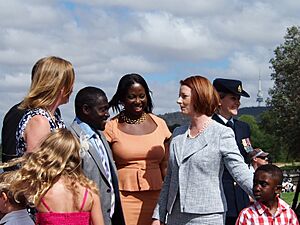
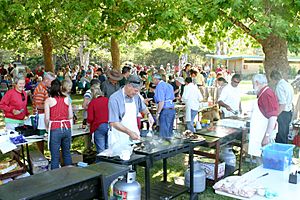
Many of the traditions we see today, like citizenship ceremonies and the Australian of the Year awards, started becoming part of Australia Day from the 1950s onwards.
After 1988, more and more people started celebrating Australia Day. In 1994, all states and territories finally agreed to have the public holiday on 26 January itself, no matter what day of the week it fell on. Studies show that many Australians attend organized events or celebrate with family and friends.
Across Australia, communities hold outdoor concerts, barbecues, sports, festivals, and fireworks. These events are often organized by the National Australia Day Council.
In Sydney, the harbour is a main focus, with boat races like the ferry race. In Adelaide, there's a parade, concert, and fireworks display. Melbourne's events often celebrate its many different cultures. Perth used to have a very large fireworks display called the Skyworks.
Citizenship ceremonies are a big part of the day. Australia Day is now the most popular day for people to become Australian citizens. On 26 January 2011, over 13,000 people from 143 countries became Australian citizens.
The Australia Day Ambassador Program sends successful Australians to local community celebrations. The Order of Australia awards are also announced. The Prime Minister announces the Australian of the Year award winner, who is an inspiring Australian citizen. There are also awards for Young Australian of the Year, Senior Australian of the Year, and Australia's Local Hero.
Many Australians think about both history and the future on Australia Day. Most believe it's important to recognize Australia's Indigenous people and culture. They also think it's important to celebrate the nation's cultural diversity.
Criticism of Australia Day
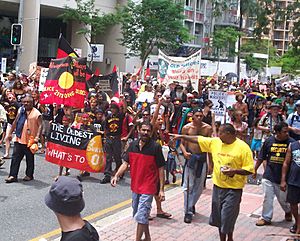
Some Australians, especially Indigenous Australians, see Australia Day as a reminder of the negative effects of British settlement on Indigenous peoples. In 1938, there was an Aboriginal Day of Mourning during the celebrations. In 1988, a large gathering of Aboriginal people in Sydney held an "Invasion Day" event to mark the loss of Indigenous culture.
Many Indigenous people and their supporters continue to call Australia Day "Invasion Day." Protests happen almost every year during Australia Day events.
The anniversary is also called "Survival Day" by some. Events like the Survival Day concert, which started in Sydney in 1992, celebrate that Indigenous people and their culture have survived despite colonization.
In response to these concerns, official Australia Day celebrations have tried to include Indigenous people. For example, the Woggan-ma-gule ceremony in Sydney honors the past and celebrates the present.
Ideas for Changing the Date
Over the years, many different dates have been suggested for Australia's national day. Some reasons for changing the date include:
- The current date celebrates the start of the Colony of New South Wales, which some feel isn't important for the whole country.
- The holiday falls during school holidays, meaning fewer schoolchildren can take part.
- It doesn't include Indigenous people and others who see the day as celebrating an invasion. Changing the date could be a powerful symbolic act.
Some important Australians, like former Australian of the Year Mick Dodson, have called for a discussion about changing the date. However, moving the date would need agreement from both the Australian Federal and State Governments. So far, there hasn't been enough political or public support for this change.
In 2004, a poll showed that 79% of Australians did not want to change the date. A 2017 poll found that only 15% of Australians supported changing the date. However, among Indigenous Australians, 54% supported a change.
Here are some other dates that have been suggested:
- Federation of Australia, 1 January – This date marks when the British colonies of Australia formed a federation in 1901, creating modern Australia. It was once called "Commonwealth Day."
- Anzac Day, 25 April – Some have suggested Anzac Day, which honors Australian and New Zealand soldiers. However, this idea has been strongly opposed by many leaders.
- Opening of the first Federal Parliament, 9 May – This date marks when Australia's first national parliament opened in Melbourne in 1901.
- Anniversary of the 1967 referendum, 27 May – This date marks a very important vote in 1967. Australians voted to change the constitution so Indigenous Australians could be counted in the national census and included under federal law.
- Eureka Stockade, 3 December – The Eureka Stockade in 1854 was a rebellion by gold miners against the government. It's seen by some as a key moment for Australian democracy.
- Constitution Day, 9 July – This is the day in 1900 when Queen Victoria approved the Constitution of Australia.
- Australia Acts commencement, 3 March – This date marks when the Australia Acts came into force in 1986. These laws removed the last legal ties between Australia and the United Kingdom, making Australia fully independent.
See also
 In Spanish: Día de Australia para niños
In Spanish: Día de Australia para niños


